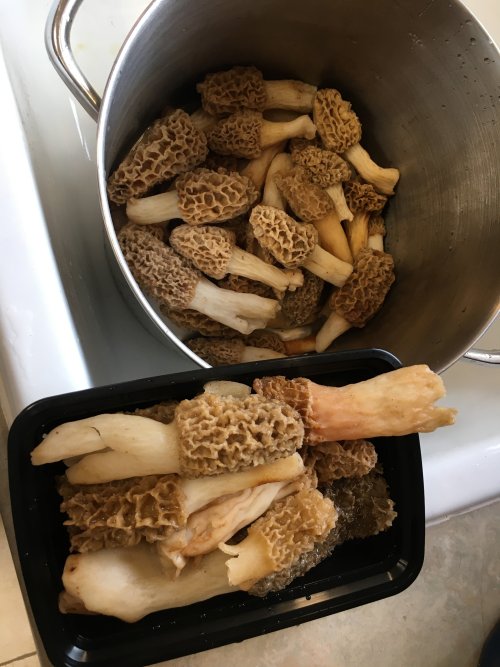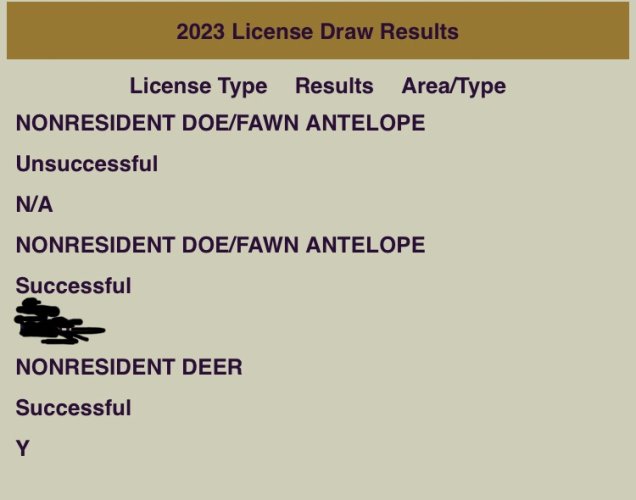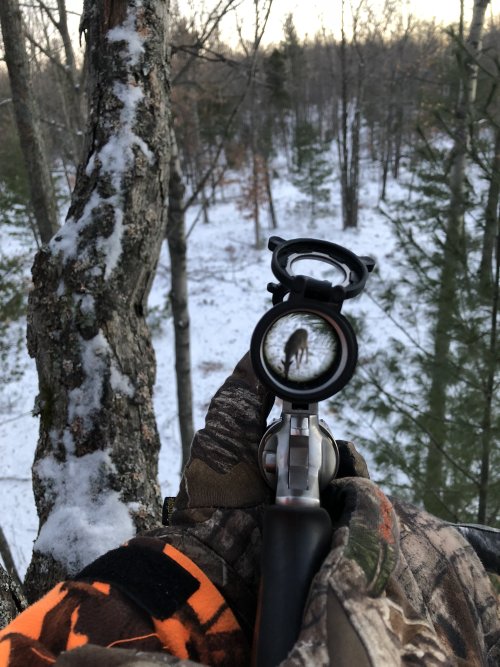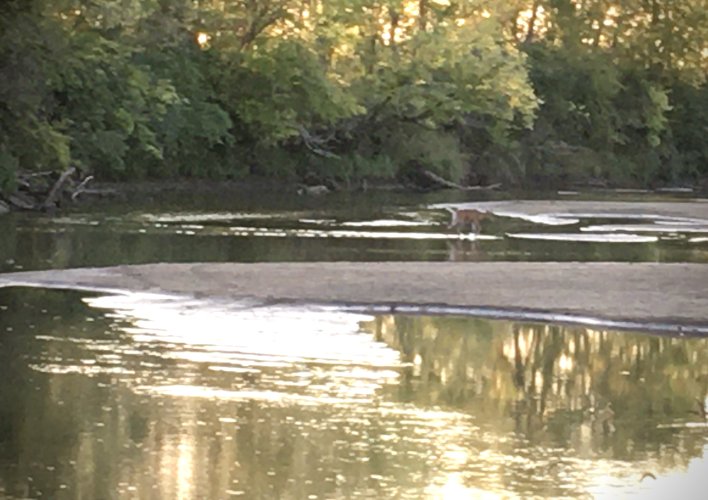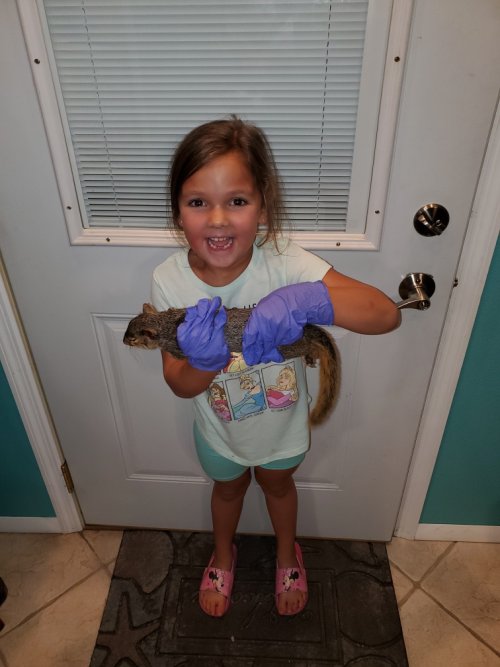Navigation
Install the app
How to install the app on iOS
Follow along with the video below to see how to install our site as a web app on your home screen.
Note: This feature may not be available in some browsers.
More options
You are using an out of date browser. It may not display this or other websites correctly.
You should upgrade or use an alternative browser.
You should upgrade or use an alternative browser.
Hunting and Bipolar
- Thread starter Pucky Freak
- Start date
Bullshot
Well-known member
Dude, just seeing these posts now. I’m sorry you’ve been struggling but as others have all said, glad you are talking, getting help and working it through (and getting in quality family and hunting time as part of that). I think we have some elements of this in common, seems many do. I hope it is comforting somewhat to know that others understand (even in pieces) your experience and its challenges. Each individual is unique and needs to tailor to their needs. Keep up the posts, we all genuinely root for your daily successes, big or small.
Benfromalbuquerque
Well-known member
- Joined
- Jul 15, 2020
- Messages
- 1,839
I empathize with all of this. I too have chosen a high risk career. I have also lost family, that’s plural, to mental health and take meds. Bonus, I take different meds for different reasons. We’re all special like that.
We who are in these professions or been deployed in war see and hear things that I wouldn’t wish upon anyone. It’s physically debilitating and mental entrapment. We say positive things to boost morale. “Would you rather be a sheep or a sheepdog protecting others from the wolves?” “Sleep is overrated, sleep when you’re dead.” Drink a pot of coffee. Brew up another. Come to falsely believe only co-workers understand what we’re feeling and don’t share with family/friends.
It takes a strong person to accept what they cannot change and take control over that which they can change. Good on you, sir, for appropriately acting upon this! Thank you so much for sharing. The more of us who share will lower the stigma of mental health and open doors which were previously closed.
We who are in these professions or been deployed in war see and hear things that I wouldn’t wish upon anyone. It’s physically debilitating and mental entrapment. We say positive things to boost morale. “Would you rather be a sheep or a sheepdog protecting others from the wolves?” “Sleep is overrated, sleep when you’re dead.” Drink a pot of coffee. Brew up another. Come to falsely believe only co-workers understand what we’re feeling and don’t share with family/friends.
It takes a strong person to accept what they cannot change and take control over that which they can change. Good on you, sir, for appropriately acting upon this! Thank you so much for sharing. The more of us who share will lower the stigma of mental health and open doors which were previously closed.
Pucky Freak
Well-known member
Bullshot
Well-known member
Nice haul but I split them down the middle after I once found a redback salamander inside a morel (must have squeezed in a tiny hole in the base). Extra protein in the worst case I guess.
Pucky Freak
Well-known member
Pucky Freak
Well-known member
Mood has been decent lately, but anxiety is way up. I find myself grinding my teeth all day and it’s hard to relax. Hypervigilance is high and I’ve been really jumpy around crowds, sudden loud noises, and extreme unease in any unfamiliar location when strangers are present. Last week got my meds switched yet again. It feels a lot like a game of whack-a-mole chasing symptoms with med changes.
June and July were full speed home repairs from the hailstorm. Total damages exceeded 40k, and I replaced 3 roofs, garage and shed siding, and installed or repaired 5 doors and 8 windows. We contracted out gutters, house siding, and the AC unit.
When all that was done my wife said why not do one more project, what the heck. I replaced garage soffit, built an exterior deck for our trash bins, installed cathedral insulation in the garage, built a rafter storage area, and installed garage air vents. We now have a clean, heated 2 1/2 car garage, which will be perfect for wintertime game butchering and auto mechanics. Pics to come.
After all that our family headed to Florida for a 2+ week vacation, and we all enjoyed the R&R. I got to see my first wild hogs, which was really cool. I took time to reflect on how I would like hunting season to shape up to be.
After much reflection I realize how much I love pursuing a variety of game. Dabbling in everything means getting good at nothing, but I can live with that.
Goals for this year:
-Hone in on squirrels with rimfires. I have 5 money spots I hope to spend more time in.
-Find at least two more good rabbit spots, which would double my options. I have 20 e-scouted areas to investigate.
-Try deer hunting with a handgun for the first time
-Buy my first fur-harvester license, shoot a coyote and a coon, and tan the pelts. Rare takes include bobcat, skunk, badger, red fox, and gray fox.
June and July were full speed home repairs from the hailstorm. Total damages exceeded 40k, and I replaced 3 roofs, garage and shed siding, and installed or repaired 5 doors and 8 windows. We contracted out gutters, house siding, and the AC unit.
When all that was done my wife said why not do one more project, what the heck. I replaced garage soffit, built an exterior deck for our trash bins, installed cathedral insulation in the garage, built a rafter storage area, and installed garage air vents. We now have a clean, heated 2 1/2 car garage, which will be perfect for wintertime game butchering and auto mechanics. Pics to come.
After all that our family headed to Florida for a 2+ week vacation, and we all enjoyed the R&R. I got to see my first wild hogs, which was really cool. I took time to reflect on how I would like hunting season to shape up to be.
After much reflection I realize how much I love pursuing a variety of game. Dabbling in everything means getting good at nothing, but I can live with that.
Goals for this year:
-Hone in on squirrels with rimfires. I have 5 money spots I hope to spend more time in.
-Find at least two more good rabbit spots, which would double my options. I have 20 e-scouted areas to investigate.
-Try deer hunting with a handgun for the first time
-Buy my first fur-harvester license, shoot a coyote and a coon, and tan the pelts. Rare takes include bobcat, skunk, badger, red fox, and gray fox.
MITCHMO
Well-known member
I can say that shooting a deer with. Handgun is a riot. I hope you can pull it off.
Pucky Freak
Well-known member
Here are my serious squirrel investments:
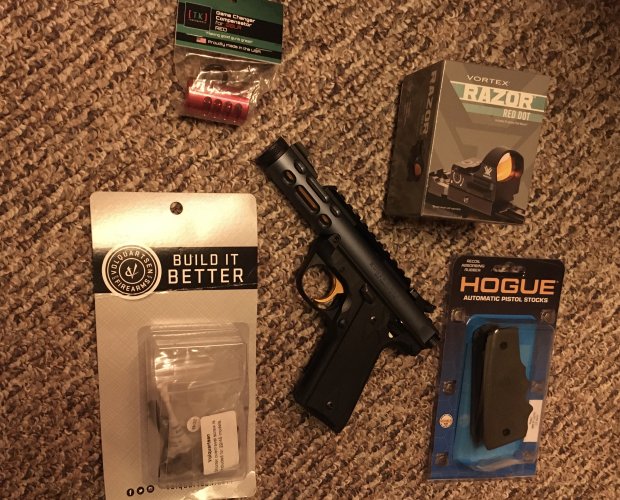
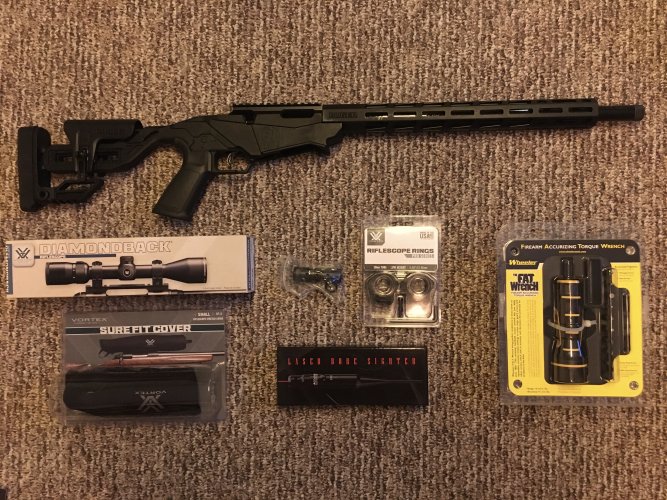
My .22 pistol grip and compensator color choices were atrocious, so they’re both being replaced with black. The contoured hogue grip feels like butter, and the Volquartsen trigger is a vast upgrade over the stock Ruger. Unfortunately, the tiny polymer notch for sear spring alignment inside the mag housing was chipped, so I’m having to send it in for repair/replace already.
Vortex is not my top choice for optics except rangefinders but I signed up for the first responder discount through EuroOptic giving me 40% off MSRP - prices are hard to pass up.
The 17 HMR rifle build is going better. I accidentally ordered the wrong diameter rings , so an exchange is in order. Also soon to arrive are M-LOK/Magpul angled foregrip and rubberized rail covers. I’m looking at about 9.5 lbs total - not ideal to lug around, so it’s mainly late season ambush to get some 60-70 yard headshots on tree rats.
, so an exchange is in order. Also soon to arrive are M-LOK/Magpul angled foregrip and rubberized rail covers. I’m looking at about 9.5 lbs total - not ideal to lug around, so it’s mainly late season ambush to get some 60-70 yard headshots on tree rats.


My .22 pistol grip and compensator color choices were atrocious, so they’re both being replaced with black. The contoured hogue grip feels like butter, and the Volquartsen trigger is a vast upgrade over the stock Ruger. Unfortunately, the tiny polymer notch for sear spring alignment inside the mag housing was chipped, so I’m having to send it in for repair/replace already.
Vortex is not my top choice for optics except rangefinders but I signed up for the first responder discount through EuroOptic giving me 40% off MSRP - prices are hard to pass up.
The 17 HMR rifle build is going better. I accidentally ordered the wrong diameter rings
Pucky Freak
Well-known member
Iowa is kind of a bittersweet state to hunt. On the plus side we have a combination of rich soil, moderate winters, and moderate rainfall, which produces an incredible amount of fecundity. Natural areas can teem with insects, flowers, birds, small mammals and other life forms. It’s fun just to be out there and soak it all in.
On the downside, Iowa has probably the most dramatically-altered landscape of any state. Native tall grass prairie once covered about 90% of the land, which was separated from riparian habitats and steep timbered areas by oak savannah ecotone. The rangeland ecosystem was maintained by vast bison herds and wildfire. We were once home to both bear species, wolves, elk, prairie chickens, sharptails, cougars, and jackrabbits. They’re all gone now, or exist only as migrants or tiny token populations.
Less than 1% of native tall grass prairie remains. It’s highly fragmented, and impossible to regenerate naturally. Row crops cover the vast majority of the landscape, leaving bare earth 5 months of the year. Over the last 50 years a variety of socioeconomic forces have progressively squeezed out what little wildlife habitat was left, leaving vast stretches of ecological desert.
Still, there are bright spots. Bobcats finished recolonizing parts of northern Iowa over the last ten years, where they had been absent for over a century. Black bears will likely re-establish a breeding population in the driftless region within the next 3 years or so. Resident elk will never be back, but we do have dispersing young bulls from central NE starting to pop up across the western half of the state as temporary migrants.
On the downside, Iowa has probably the most dramatically-altered landscape of any state. Native tall grass prairie once covered about 90% of the land, which was separated from riparian habitats and steep timbered areas by oak savannah ecotone. The rangeland ecosystem was maintained by vast bison herds and wildfire. We were once home to both bear species, wolves, elk, prairie chickens, sharptails, cougars, and jackrabbits. They’re all gone now, or exist only as migrants or tiny token populations.
Less than 1% of native tall grass prairie remains. It’s highly fragmented, and impossible to regenerate naturally. Row crops cover the vast majority of the landscape, leaving bare earth 5 months of the year. Over the last 50 years a variety of socioeconomic forces have progressively squeezed out what little wildlife habitat was left, leaving vast stretches of ecological desert.
Still, there are bright spots. Bobcats finished recolonizing parts of northern Iowa over the last ten years, where they had been absent for over a century. Black bears will likely re-establish a breeding population in the driftless region within the next 3 years or so. Resident elk will never be back, but we do have dispersing young bulls from central NE starting to pop up across the western half of the state as temporary migrants.
Benfromalbuquerque
Well-known member
- Joined
- Jul 15, 2020
- Messages
- 1,839
Betcha $1,000 resident elk do return to IA in 25yrs. They’re pushing up out of KY from the South and NE is already booming. The State will deny any scientific knowledge of elk for as long as they can. We’ve all seen the playbook across the country over the years. I’m old enough to remember when coyotes “didn't exist” and then were “rare” from Ohio to the Atlantic. Nowadays we got dedicated predator hunters in NY state. Reports of wolves in ME, badgers in south TX, elk in VA, wolverines in CA.Iowa is kind of a bittersweet state to hunt. On the plus side we have a combination of rich soil, moderate winters, and moderate rainfall, which produces an incredible amount of fecundity. Natural areas can teem with insects, flowers, birds, small mammals and other life forms. It’s fun just to be out there and soak it all in.
On the downside, Iowa has probably the most dramatically-altered landscape of any state. Native tall grass prairie once covered about 90% of the land, which was separated from riparian habitats and steep timbered areas by oak savannah ecotone. The rangeland ecosystem was maintained by vast bison herds and wildfire. We were once home to both bear species, wolves, elk, prairie chickens, sharptails, cougars, and jackrabbits. They’re all gone now, or exist only as migrants or tiny token populations.
Less than 1% of native tall grass prairie remains. It’s highly fragmented, and impossible to regenerate naturally. Row crops cover the vast majority of the landscape, leaving bare earth 5 months of the year. Over the last 50 years a variety of socioeconomic forces have progressively squeezed out what little wildlife habitat was left, leaving vast stretches of ecological desert.
Still, there are bright spots. Bobcats finished recolonizing parts of northern Iowa over the last ten years, where they had been absent for over a century. Black bears will likely re-establish a breeding population in the driftless region within the next 3 years or so. Resident elk will never be back, but we do have dispersing young bulls from central NE starting to pop up across the western half of the state as temporary migrants.
I think the reason States deny or obfuscate any reports of non-game animals establishing populations is without a funded years-long study it’s only anecdotal reports. And if it’s not formally studied then it doesn’t exist. The reality of that cat on the Ring doorbell camera being a mountain lion makes people frightened and any good State G&F stooge would tell the reporter it was probably an escaped pet.
MITCHMO
Well-known member
TheBenHoyle
Well-known member
I feel the same way about the natural" landscape of Illinois where I live. There are a lot of good things happening, but then you'll drive past a spot where a fencerow was bulldozed and now there is a huge cornfield with no habitat breaks for a half mile.Iowa is kind of a bittersweet state to hunt. On the plus side we have a combination of rich soil, moderate winters, and moderate rainfall, which produces an incredible amount of fecundity. Natural areas can teem with insects, flowers, birds, small mammals and other life forms. It’s fun just to be out there and soak it all in.
On the downside, Iowa has probably the most dramatically-altered landscape of any state. Native tall grass prairie once covered about 90% of the land, which was separated from riparian habitats and steep timbered areas by oak savannah ecotone. The rangeland ecosystem was maintained by vast bison herds and wildfire. We were once home to both bear species, wolves, elk, prairie chickens, sharptails, cougars, and jackrabbits. They’re all gone now, or exist only as migrants or tiny token populations.
Less than 1% of native tall grass prairie remains. It’s highly fragmented, and impossible to regenerate naturally. Row crops cover the vast majority of the landscape, leaving bare earth 5 months of the year. Over the last 50 years a variety of socioeconomic forces have progressively squeezed out what little wildlife habitat was left, leaving vast stretches of ecological desert.
Still, there are bright spots. Bobcats finished recolonizing parts of northern Iowa over the last ten years, where they had been absent for over a century. Black bears will likely re-establish a breeding population in the driftless region within the next 3 years or so. Resident elk will never be back, but we do have dispersing young bulls from central NE starting to pop up across the western half of the state as temporary migrants.
I would love to see the state re-establish an elk population, but the legislature declined to take those steps back in the early 00's.
There is a bison population in the state now at the decommissioned Joliet Arsenal, now known as Midewin National Tallgrass Prairie. Sadly, they are high fence show animals ostensibly being studied for their beneficial effects on prairie restoration. Maybe someday they will actually turn into a free-range population that can be hunted.
Won't happen in my lifetime, but it makes me hope that wildlife will continue to be available to enjoy out in the field.
Pucky Freak
Well-known member
I should have done a before pic - it looked like a drive-by shooting with buckshot (tennis ball-sized hailstones)
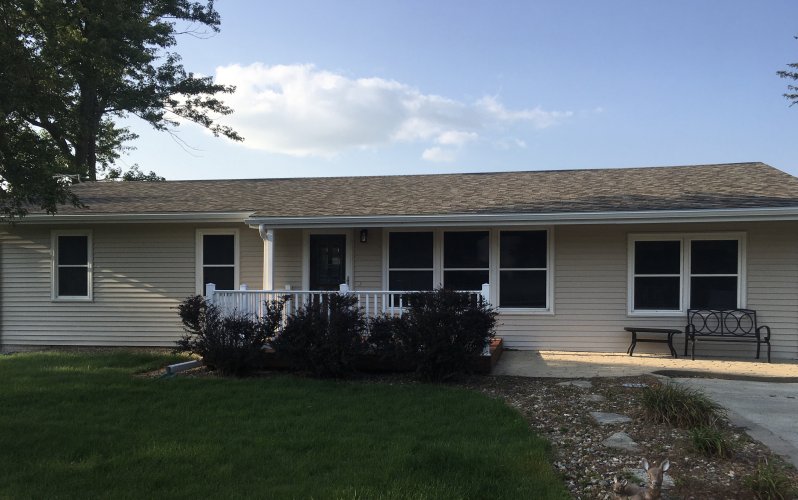
Everything pictured here was replaced except a few trim pieces on the shed.
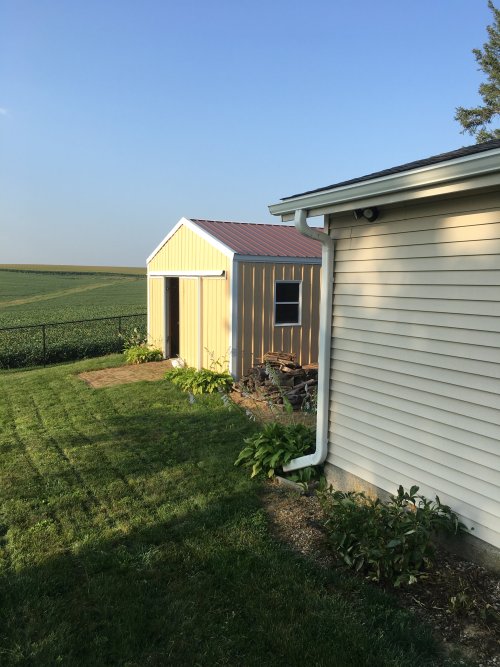
Moving trash to side of the garage cuts out the odor. I guess I do need to apply stain yet.
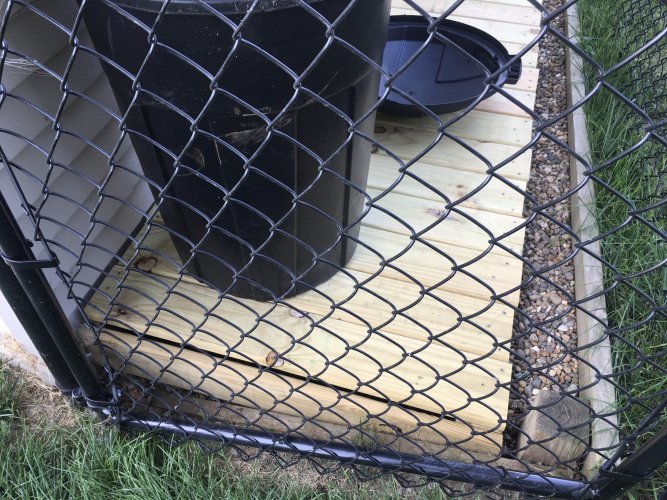
It’s kind of hard to see the angles with the uniform materials, but the triangle on the left side is the top inside front wall of the garage, 2” rigid foam behind the OSB. Under the roof are 22 full length vent chutes, eave to roof peak, then 24” x 5” fiberglass batts, and finally, 7/16” OSB to encapsulate. Doing the OSB alone with no lift was interesting. Kind of like fabricating a 3D jigsaw puzzle one piece at a time, then assembling the 46 lb. sheets upside down. Garage is 100% insulated now and surprisingly very quiet when the doors are shut. 1973 trusses are dual king post, which is not great for maintaining the roof shape over time, but it did allow me space to install 350 sq ft of rafter storage.
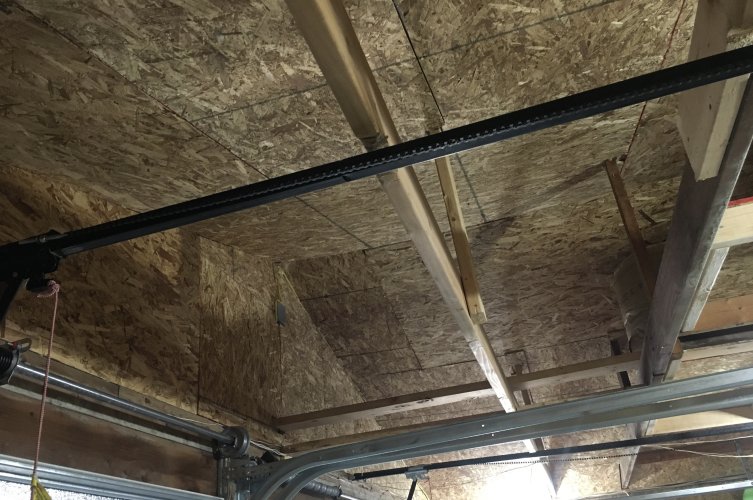
My wife says all I need now is a couch!
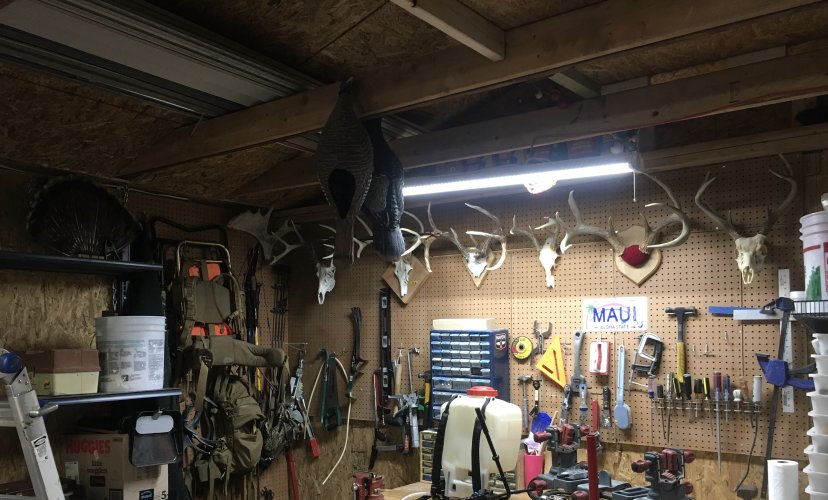

Everything pictured here was replaced except a few trim pieces on the shed.

Moving trash to side of the garage cuts out the odor. I guess I do need to apply stain yet.

It’s kind of hard to see the angles with the uniform materials, but the triangle on the left side is the top inside front wall of the garage, 2” rigid foam behind the OSB. Under the roof are 22 full length vent chutes, eave to roof peak, then 24” x 5” fiberglass batts, and finally, 7/16” OSB to encapsulate. Doing the OSB alone with no lift was interesting. Kind of like fabricating a 3D jigsaw puzzle one piece at a time, then assembling the 46 lb. sheets upside down. Garage is 100% insulated now and surprisingly very quiet when the doors are shut. 1973 trusses are dual king post, which is not great for maintaining the roof shape over time, but it did allow me space to install 350 sq ft of rafter storage.

My wife says all I need now is a couch!

Nick87
Well-known member
Looks good!
duckhunt
Well-known member
Dang you have had a busy summer. I'm also thinking about targeting the bushy tails this fall. I haven't hardly done any of that for quite some time.
Pucky Freak
Well-known member
Pucky Freak
Well-known member
Pucky Freak
Well-known member
New spot. Chased foxy for about 100 yards until she posted up, allowing for a headshot. Then moved into greys deep timber habitat, and shot 3 out of the same shagbark hickory tree.
My daughter is fighting a head cold so she can’t tag along just yet, but when I got home she wanted to handle each animal and ask about a million questions, haha
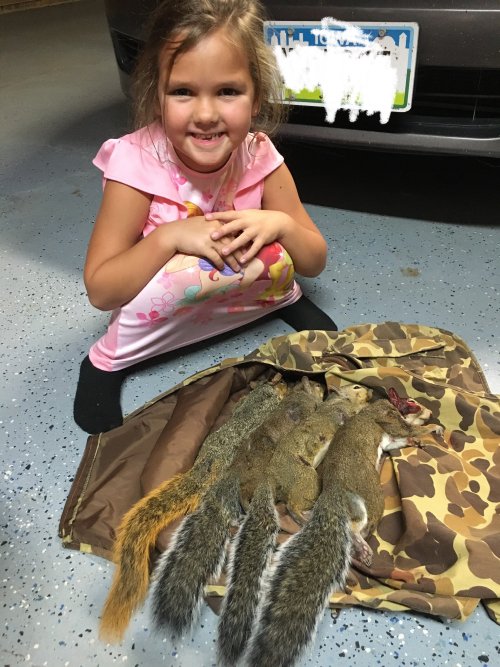
My daughter is fighting a head cold so she can’t tag along just yet, but when I got home she wanted to handle each animal and ask about a million questions, haha

Similar threads
- Replies
- 29
- Views
- 746




